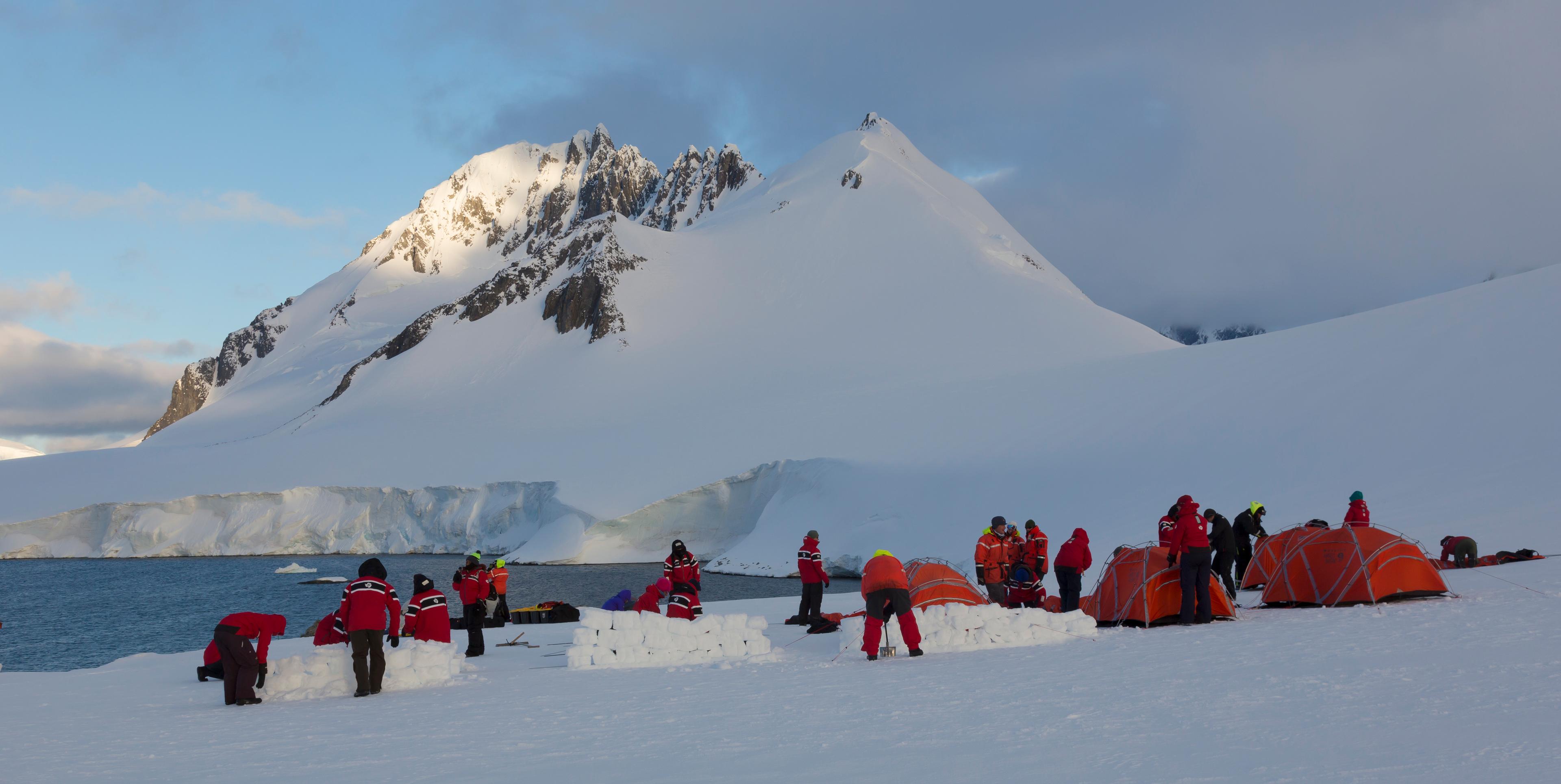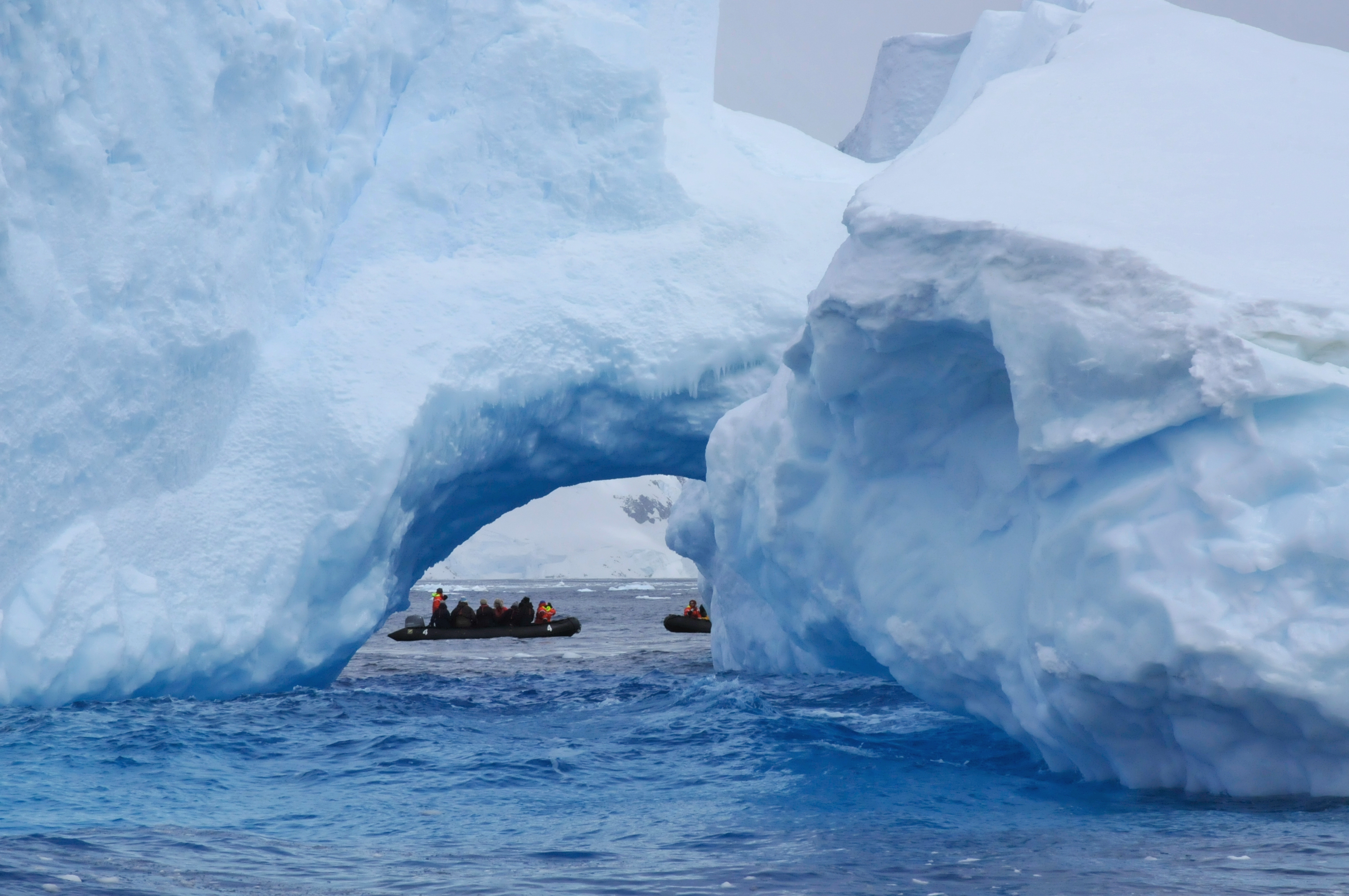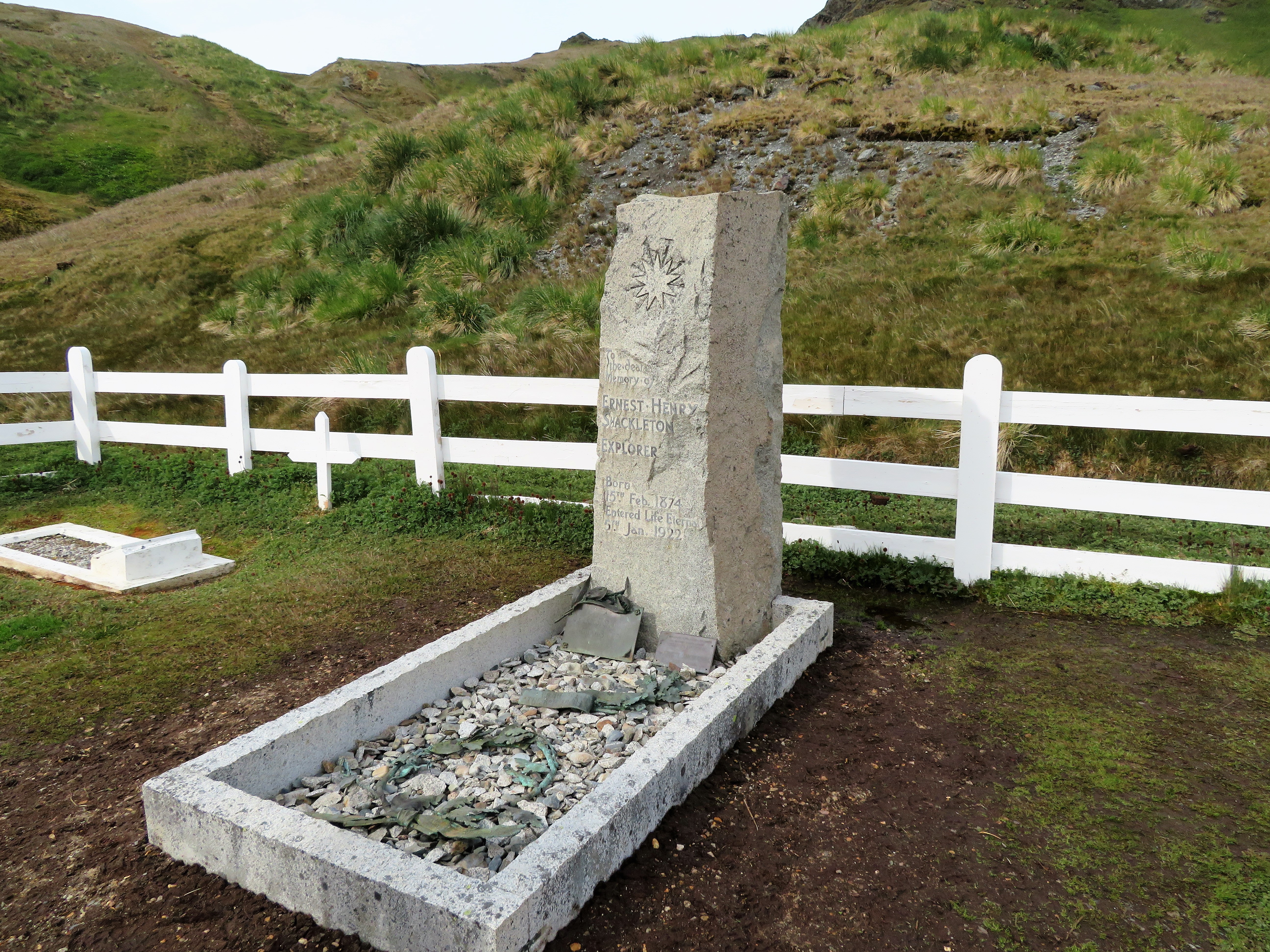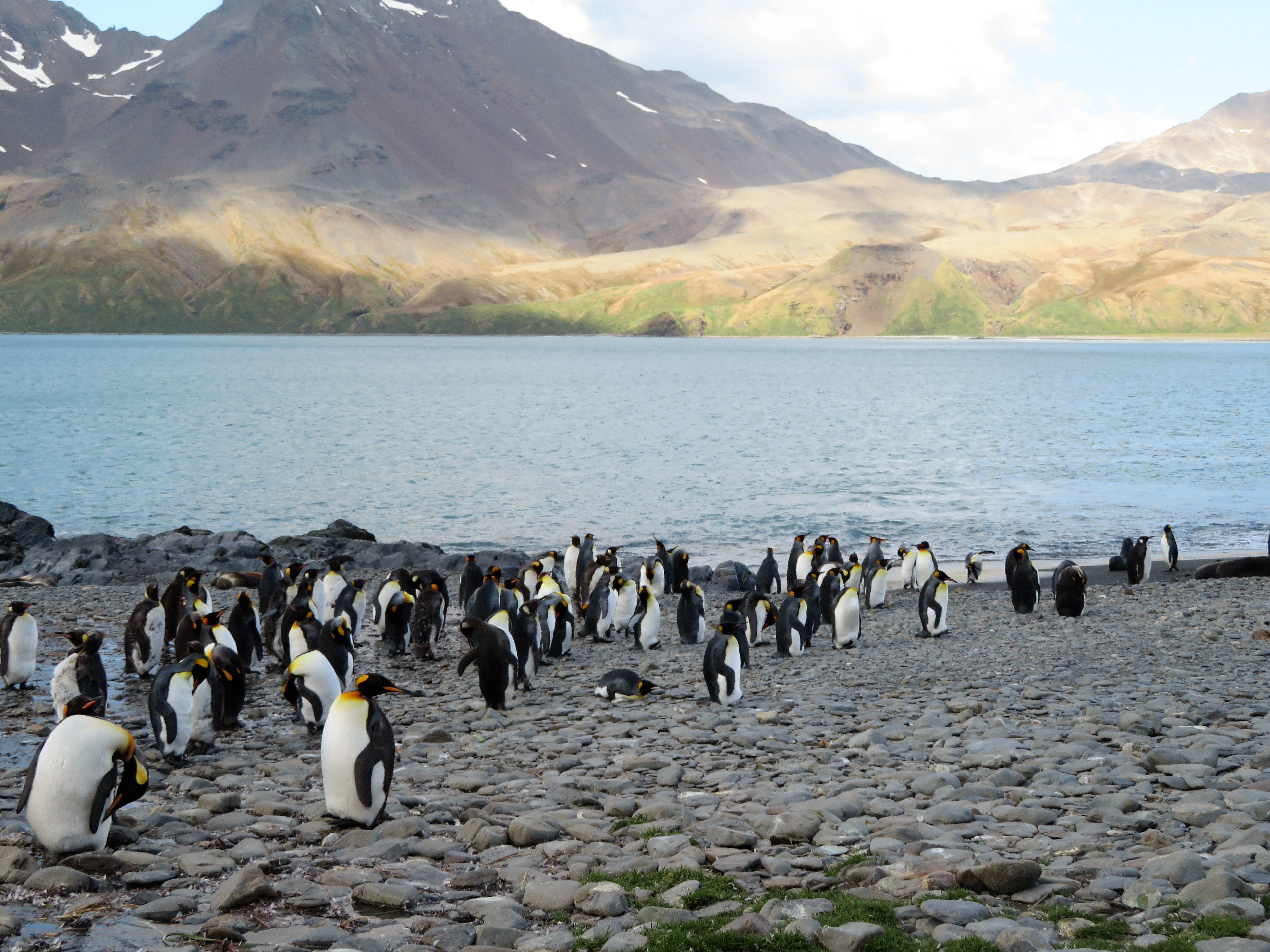What Draws You to Antarctica?
The first thing you have to ask yourself is why you want to go to Antarctica. Is it a bucket list item to reach the 7th continent? Do you want to cross the Antarctic Circle? Are you a historian who wants to trace Shackleton’s journey? Are you a birder, excited to see the magnificent albatross? Do you want to see as many penguin types as Antarctica has to offer? Is it the dramatic landscapes, or should I say, ice-scapes, that attract you?
Do you want to follow Shackleton’s Journey?
Do you want to follow Shackleton’s expedition and consume the insanity of what he and his team accomplished? There are specific itineraries that will bring you to his grave, to the inlet where his boat landed in South Georgia; to the waterfall where he and his team descended; to Elephant Island where you’ll see where those he left behind stayed for 4 months; where a bust of the captain is mounted, the captain who rescued them.
Is Crossing the Antarctic Polar Circle on your Bucket List?
Only specific itineraries will make this attempt. Time of year is critical to when this can happen.
Do you have a Penguin agenda?
Do you want to see all 7 penguins? Macaroni and Emperor penguins are not seen on every journey. To see the Emperor penguin, you’ll probably have to travel the Weddell or Bellingshausen Seas . Only a small proportion of itineraries go there. The king penguin is found only in South Georgia and the subantarctic islands at the northern reaches of Antarctica – meaning, you’ll not want to miss South Georgia. Penguins and other seabirds court and lay eggs from November to December.
Are you an avid Whale Watcher?
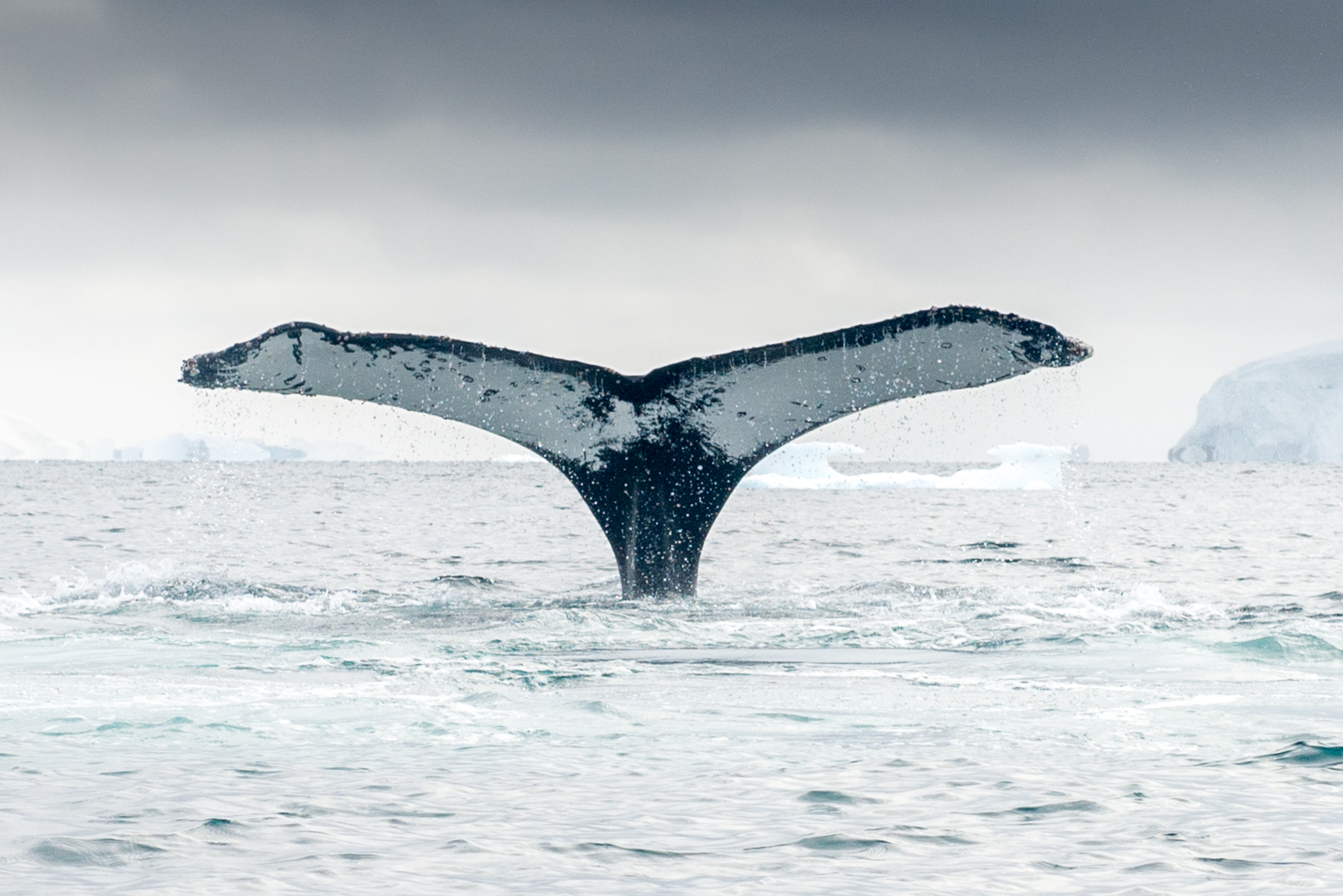 While we saw many whales throughout our journey, we weren’t out in zodiacs following them. But, if that’s what you want, there are specific itineraries focused on whale watching. Whale-watching is prime from December to February, particularly in places like Wilhelmina Bay. From February to March, sightings of humpback, minke, and killer whales are more plentiful.
While we saw many whales throughout our journey, we weren’t out in zodiacs following them. But, if that’s what you want, there are specific itineraries focused on whale watching. Whale-watching is prime from December to February, particularly in places like Wilhelmina Bay. From February to March, sightings of humpback, minke, and killer whales are more plentiful.
Are you a Birder?
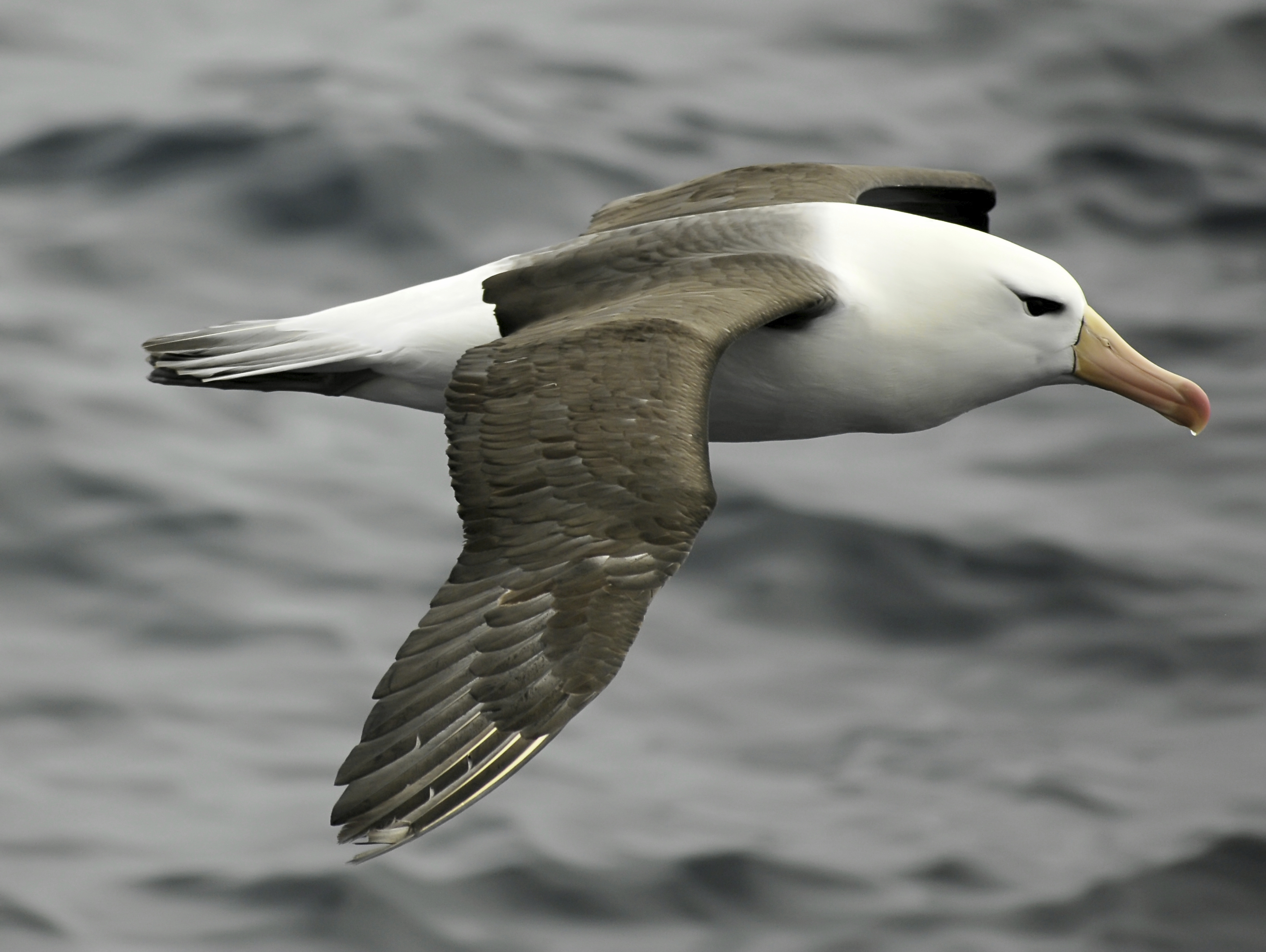 If yes, this means that you’ll absolutely want to make sure your itinerary includes South Georgia Island, and more specifically, Prion Island. You’re likely to see albatross, including the Wandering, Light-mantled, grey-headed, and Black-browed. King, Gentoo, Chinstrap, Macaroni and Rockhopper penguins are also common to South Georgia.
If yes, this means that you’ll absolutely want to make sure your itinerary includes South Georgia Island, and more specifically, Prion Island. You’re likely to see albatross, including the Wandering, Light-mantled, grey-headed, and Black-browed. King, Gentoo, Chinstrap, Macaroni and Rockhopper penguins are also common to South Georgia.
Penguins and other seabirds court and lay eggs from November to December.
On the Antarctic Peninsula, you’ll be drawn to Neko Harbour because of the concentration of Skua birds that dominate the rocky outcroppings above the landing beach.
You love all Wildlife?
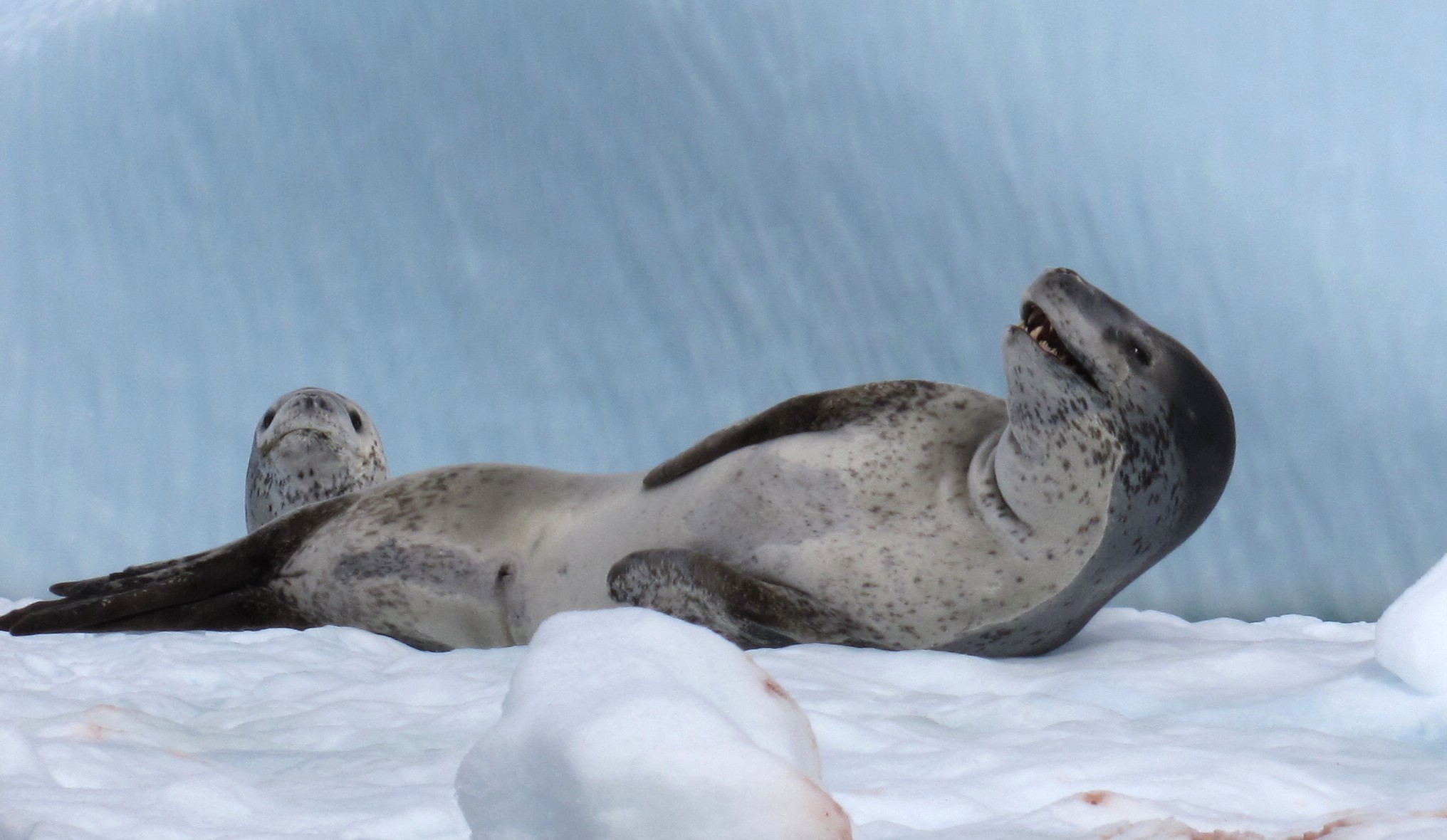 If you are interested in all-things-wildlife, you will see plenty in South Georgia and Antarctica. At the height of breeding season in South Georgia, there is said to be more wildlife per square foot than any other place on the planet.
If you are interested in all-things-wildlife, you will see plenty in South Georgia and Antarctica. At the height of breeding season in South Georgia, there is said to be more wildlife per square foot than any other place on the planet.
Danco Island in Antarctica is home to more than 2,000 pairs of breeding Gentoo penguins, which occupy the slopes on the northern coast of the island. Weddell seals congregate on the offshore rocks and beaches. Wildlife enthusiasts can expect to see Humpback and Minke whales as they pass through the Errera Channel at the end of summer.
Just want to see what Antarctica has to offer in general?
If you just want to take in what Antarctica has to offer, then you’ll be open to itineraries that suit your available time, for the duration you’re interested in, and the type of accommodation you are comfortable with. Any one itinerary will allow you to experience the wonders of Antarctica.
What is Holding You Back?
Is there anything holding you back? You don’t like the cold; you don’t like the cost; you don’t want to cross the Drake Passage? Luckily, there are itineraries that can minimize or eliminate these issues.
Let’s talk about the Weather
Trips to Antarctica start to occur as early as late October/early November all the way up to the end of March. You have to remember that this being in the southern hemisphere, represents Antarctica’s summer. This also means that the days are long, well in excess of 12 hours a day.
Here are some metrics for an average January:
| Location | °C | °F |
| King George Island, South Shetland Islands | 1.5 | 34.7 |
| South Georgia Islands | 5.5 | 41.9 |
| Antarctic Peninsula | 1.5 | 34.7 |
| Falkland Islands | 9 | 48 |
As you can see, these temperatures aren’t frightening. We were provided with a waterproof and windproof jacket – and it worked just fine. A couple of layers underneath – and no discomfort. As well, you can limit your trip to say, just The Falklands and South Georgia – where the experience is terrific but the temperatures more to your liking.
And Then There is the Drake Passage
Coupled with the area's propensity for high wind, a crossing of the Drake Passage can be quite the adventurous exploit. Luckily, expedition vessels nowadays are equipped with stabilizers to absorb much of the swaying and most Antarctica cruise ship passengers get by with just a sea sickness tablet and a few crackers.
We went through the Drake Passage for two days in 20-meter swells. It was the roughest water that our ship had experienced that season. Having said that, we were in a ship that could hold 380 or so guest. Its size was somewhat comforting. Watching the waves from the observation deck on the 7th floor, was mesmerizing. You could tell when we were going to hit a swell that would result in the entire front of the ship being covered in water. And when dining, you could see the swells spew for what seemed like a mile out from the side of the ship in either direction. I felt neither unsafe nor doubted the capability of our Captain and ship. I did use a motion illness patch and would recommend such.
While some might look most forward to crossing the Drake Passage as part of their Antarctica experience, I appreciate that for others, it might be the thing most feared. The reason I bring this up is that there are fly/cruises – where you can do a combination of flying to and/or from the South Shetland Islands to avoid the Drake Passage.
What Ship is Best for Me?
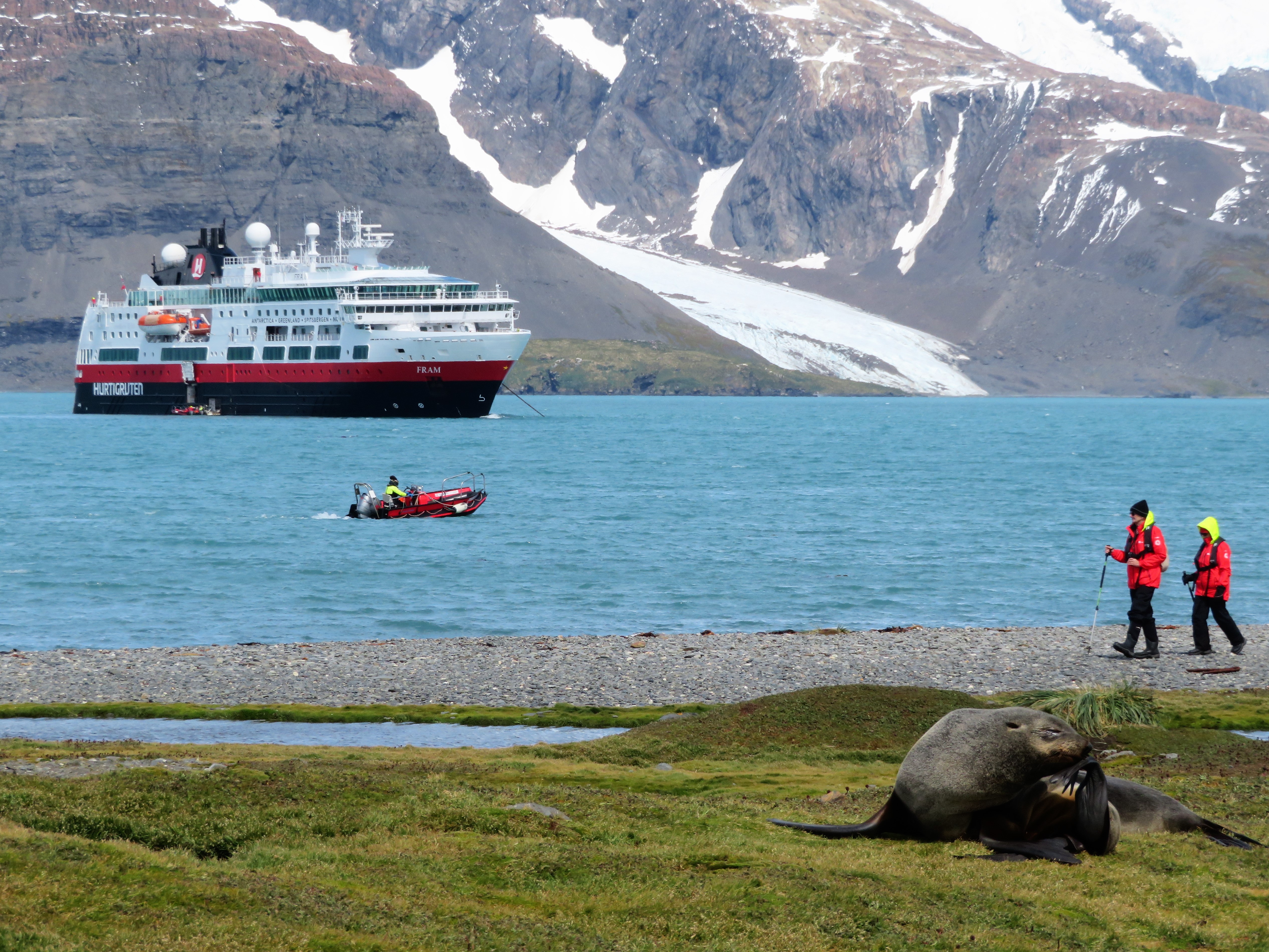
Only ships with 500 or fewer passenger capacity can make landings in Antarctica. And only 100 people can be on land at a time. The “100 on land at a time” matters as it impacts how long it takes to get on land, the type of activities you can do while there, and the duration of such activities.
Ships carrying 201 to 500 passengers have fewer options for landing sites to which they can transport their guests.
A 200-guest ship is going to have to cycle passengers to and from the land in a way that ensures that no more than 100 people are on land at a time. Guests determine when they want to take the next zodiac back. This means that there is no precise indicator of when it will be your turn to get on land. Because land excursion time is limited, you might not have the option to snowshoe, for example, or go on an extended hike. An on-land experience may last from 30 minutes 1 ½ hours.
On ships of 100 passengers or fewer, you all get to go to shore at once and get to stay for up to 2 1/3 to 3 hours. This also means that people who opt for kayaking, may also get to spend time on land. On larger ships with up to 200 passengers, you can kayak or you can do the land adventure – but not likely both.
Another consideration relates to the space-to-guest ratio. A ship that was built for 200 guests will be less spacious than a ship that was built for 400 guests, but has only 200 on board. The lounges will have more capacity and there may be more amenities (larger gyms, libraries, lecture areas, dining capacity). Having said that, they also use more fuel per capita.
Accommodations – Comfort, Food, and Service
Accommodations on ships to Antarctica range from basic to luxurious. Luxurious may or may not be all-inclusive. Some ships have balconies; some do not. Some accommodate solo travellers with no single supplement while others charge a stiff premium. These elements are generally ship-specific, as different ships from the same cruise operator may have completely different accommodation styles and facilities.
Is Antarctica a small offering of the cruise company or is this their focus during Antarctica’s summer?
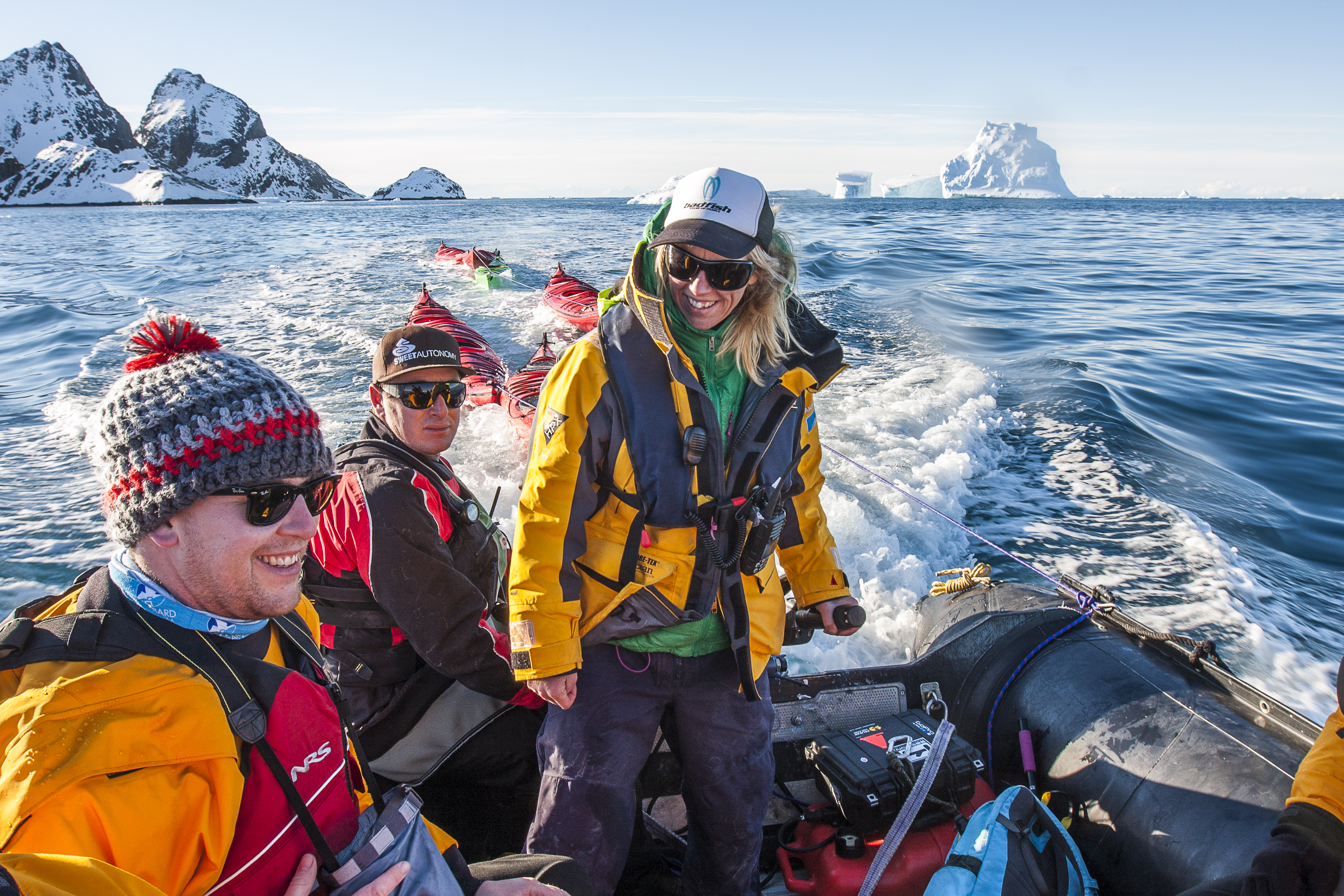 This matters in terms of the expedition team and experts on board. Part of an expedition includes lectures and regular meetings that go over, not only what you saw in a day and what you’ll see the next, but educate you on the research being done, the lay of the land, the wildlife and issues around food and climate, to name a few.
This matters in terms of the expedition team and experts on board. Part of an expedition includes lectures and regular meetings that go over, not only what you saw in a day and what you’ll see the next, but educate you on the research being done, the lay of the land, the wildlife and issues around food and climate, to name a few.
On our MS Fram Hurtigruten voyage, we had lectures from a person with a PhD on Krill! At one stop, we took on board two researchers who did a presentation for us on how they were tracking penguins to ensure that krill fishing didn’t impact their ability to feed their chicks during critical times. In exchange, Hurtigruten fed them and allowed them to shower and use their laundry facilities. These relationships only happen when you are a cruise company immersed in the area. So, if you want an immersive experience, you’ll want to use a cruise company that does Antarctica in spades.
What Itinerary should I do?
The more time you have, the more you can see
You can find trips that are as short as 6 days to well over 20 days. If you do the full Falkland Islands, South Georgia, and Antarctic Peninsula itinerary, you can expect a time commitment of 19 to 23 days. If you can’t spare that much time, you’ll have to determine what your primary objectives are.
The ability to fly in and/or out to the Shetland Islands, over the Drake Passage, can shave 2 to 4 days off of your journey and still allow you to have an immersive experience.
Here are 13 themed itineraries that highlight some of the experiences you’ll have:
| Sample Itinerary | Approximate Duration | Typical Experiences |
| Shackleton | 21 Days | Shackleton’s Journey Wildlife – penguins, birds, whales, seals Falkland Islands, South Georgia and Antarctic Peninsula |
| Antarctic Circle | 14 Days | Cross the Antarctic Circle Wildlife – penguins, birds, whales, seals Antarctic Peninsula |
Antarctic Classic | 11 Days | Wildlife – penguins, birds, whales, seals Antarctic Peninsula |
Emperor Penguins – Bellingshausen Sea | 20 Days | Emperor Penguins in addition to other Antarctica wildlife and sites |
| Discovery of Antarctica, Patagonia, and Chilean Fjords (incl. Falkland Islands) | 18 Days | Wildlife – penguins, birds, whales, seals Patagonia Chilean Fjords Cape Horn Falkland Islands |
Antarctica, Patagonia, and Chilean Fjords (Torres del Paine, Cape Horn)
| 19 Days | Wildlife – penguins, birds, whales, seals Patagonia Chilean Fjords Cape Horn Torres del Paine, Chiloe National park – optional excursions |
| The Weddell Sea & Larsen Ice Shelf | 13 Days | Tabular icebergs Eastern side of the Peninsula Wildlife: Weddell and elephant seals; an abundance of penguins; Humpback whales and the leopard seal |
| The Weddell Sea & the South Sandwich Islands | 19 Days | Tabular icebergs Eastern side of the Peninsula Wildlife: Weddell and elephant seals; an abundance of penguins; Humpback whales and the leopard seal; Antarctic fur seals; sei, fin, and minke whales. |
| Weddell Sea - Emperor Penguin Voyage | 11 Days | See penguins by ship-to-shore helicopter transfer (Snow Hill) Western side of Antarctica Sound – layered sandstone, lava flows, glaciers and icebergs. Wildlife: Emperor penguins, adelie penguins, giant petrels, kelp gulls, skuas, and Wilson’s storm petrels. |
| The Ross Sea | 33 Days | Wildlife: Killer whales, Humpback whales, Minke whales, Leopard Seals, Crabeater Seals, Ross Seals, possibly emperor penguins and baleen ales. |
| Expedition to Charcot & Peter I Islands | 16 Days | Wildlife: humpback whales, gentoo penguins, Weddell seals Explore islands below the Antarctic Circle |
| The Falklands and South Georgia | 15 Days to 17 Days | World’s largest black-browed albatross colony Biggest breading spots for King Penguins and Elephant seals |
| Explorers Cruise: Antarctic Peninsula and the Extreme Weddell Sea | 11 Days to 16 Days | South Shetland Islands and the Antarctic Peninsula Follow in Ernest Shackleton and rest of the Endurance crews wake close to Elephant Island Giant ice shelves Wildlife: Adelie penguins, giant petrels, kelp gulls, skuas, and Wilson’s storm petrels. |
How Much Will a Trip to Antarctica Cost?
In terms of cost, any where from $750 USD to $1500 USD per day per passenger would be an appropriate budget for the most conservative accommodations of a given ship. You might want to double that for something more comfortable. This does not include international flights to Chile or Argentina.
Note: Hurtigruten offers a 15% discount to Canadian Residents to compensate for the exchange rate to USD. G Adventures pricing is in Canadian dollars.
Factor into the costs, the requirement for medical evaluation insurance. Quark Expedition includes emergency evacuation insurance to a maximum benefit of $500,000 USD per person.
Other Considerations
Protect the Environment by Traveling with a company that operates Antarctic Treaty and IAATO Requirements Compliant
Tourism to Antarctica is regulated by the International Association of Antarctica Tour Operators (IAATO), founded in 1991 by seven tour operators, including Lindblad. Though membership is voluntary, IAATO now has more than 100 members, all directly or peripherally engaged in Antarctic tourism. Members must agree that their activities in the region have “minor and transitory impact,” according to Gina Greer, the organization’s executive director. Greer’s been with IAATO for a year and says she’s not found a more cohesive organization. “The collaboration among members is high. They’re all working together to help manage activities and be respectful to the environment. They all benefit from their shared knowledge of the region and agree on guidelines that everyone works to meet.”
The following elements may or may not be included with your cruise fare. It is important to know what you are and are not responsible for when assessing the cost of your trip. Your travel advisor can help you with these details.
Air Travel and Airport Transfers:
Some itineraries start in Ushuaia or Punta Arenas – and require that you make flight arrangements to get there, along with arranging your own transfers to the ship. Others start in Buenos Aires and include the flight to and from Ushuaia along with airport and hotel transfers.
Travel Insurance:
You will require emergency medical evacuation insurance. Quark Expeditions does insure each person up to $500,000 USD but other cruises do not.
Beverages:
Some include beer and wine during lunch and dinner; others don’t. Some go beyond and include alcoholic beverages at your leisure. In some, soft drinks are only available for free with meals.
Luggage Restrictions:
On Air/Cruise itineraries, the maximum luggage weight allowed on flights to and from Antarctica is 20 kg (44 lbs.) per passenger, including hand luggage. For trips starting and ending in Punta Arenas, luggage exceeding this weight limit can be left in custody with Antarctica21. This luggage custody service is not available for Antarctica Express Air-Cruises starting in Ushuaia. This restriction also applies to any fly/cruise option with other operators.
WiFi:
Expect intermittent access. Some ships may include wifi; others you can purchase.
Tips:
Depending on where the ship is registered, different tipping rules will apply. Hurtigruten, for instance, does not expect tips.
Pricing:
Most pricing is in USD. You will bear the foreign exchange risk if paying with a non-USD credit card. G Adventures quotes on Canadian Dollars.
Meal Preferences:
Because of the ship size and itinerary, not all food options can be accommodated. While you should be able to find vegetarian and possibly vegan options, you might not find accommodations for Halal and Kosher foods, for example. Food allergies are likely to be accommodated.
Most cruise operators will require that you fill out a form specific to your food needs and will do their best to accommodate. For very particular needs, you should have your travel advisor obtain specifics about a particular ship’s food accommodations.
Solo Travellers:
Adventure Canada has been the recipient of the 2018 World Nomads Solo Traveler award, presented to companies that excel at serving solo travellers by offering tours, cruises, and vacation packages with no or very low single supplements.
Other companies also offer limited solo suites at no extra cost per person while G Adventures will allow solo travellers to share a room with a person of the same sex with no single supplement.
Ocean Albatros, operated by Albatros Expeditions has 12 dedicated solo travel cabins without a single supplement. Their sister Ocean Victory has 5 dedicated solo cabins.
Antarctica 21 solo travelers can book a dedicated Single Cabin. No supplement is applied for single use of dedicated Single Cabins. Alternatively, solo travellers can opt to share a cabin with another passenger of the same gender. This is available on Magellan Explorer in Porthole and Veranda Cabins, on Ocean Nova in Twin Cabins, and on Hebridean Sky in Window Suites and Promenade Suites. Antarctica21 will take care of finding the matching companion. Passengers who book a Twin Cabin on a shared basis are accommodated in single rooms at the hotel in Punta Arenas for which they must pay a Single Hotel Room Supplement that varies based on the departure selected.
Hurtigruten often has promotional offers that eliminate single supplements. They are time-sensitive and usually offered as departure dates approach.
Languages for Announcements and Communications:
While all ships will provide announcements and communications in English, English may not be the dominant language of the ship. This will be dictated by the origin of the ship operator/owner and the markets they cater to. Some ships only operate in English which others will provide announcements in other languages, representative of the guests on the ship.
G Adventures, Quark Expeditions, Adventure Canada, Antarctica 21, Silver Seas and Seabourn all operate in English. Ponant is bilingual: French and English. Hurtigruten ships will often be multi-lingual.
Ready to plan your Antarctica adventure of a lifetime? Let’s chat. You can sign up to schedule a consultation or sign up for my weekly newsletter for more inspiration.

